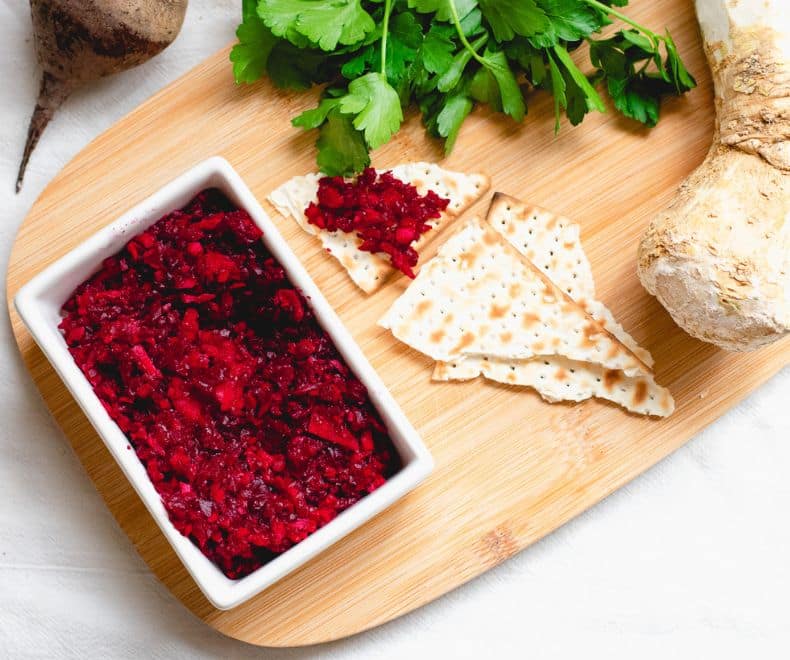The beautiful pink color adds a nice touch to your Passover plate, and the combination of horseradish and beets provides a delicious and unique flavor. It will surely be a hit with your Passover guests!
Cooking for Passover? Try my Passover Mandel Bread, Charoset with Dates, and Toffee Matzo Brittle.
Ingredients Overview
*The full recipe is in the recipe card below!
Cooked beets: Preheat the oven to 375°F/190°C. Wash the beets and trim off the leaves and root ends. Wrap the beets in aluminum foil and roast them in the oven for about an hour or until they are tender when pierced with a fork. Let the beets cool. Peel the cooled beets and cut them into chunks.
Fresh horseradish root: Horseradish root should have a beige or cream color on the outside and white on the inside. The root should be firm, smooth, and heavy for its size. It should not be soft, wrinkled, or show any mold or discoloration. Horseradish root can usually be found in the produce section of most grocery stores or specialty food stores; availability may vary by location and season.
Seasoning: Apple cider vinegar, sugar, and salt.
Pro-Tips
- Safety precautions: Horseradish can be very pungent and may cause eye irritation or respiratory discomfort if you inhale the fumes. It’s important to work in a well-ventilated area and wear gloves or wash your hands thoroughly after handling horseradish.
- Peeling: Use a vegetable peeler or sharp paring knife to remove the skin from the horseradish root.
- Ratio between the horseradish and the beets: Generally, the horseradish ratio to beets is about 1 to 3, giving this dish a milder taste. I would suggest starting with just a few cubes of fresh horseradish and slowly adding more if needed.
- Adjusting the heat: The heat level of horseradish can vary depending on the freshness and potency of the root. If you find that your horseradish is too spicy, you can tone down the heat by adding more vinegar and cooked beets.
FAQs
Horseradish is a traditional condiment served during Passover to symbolize the bitterness of the Jewish people’s enslavement in Egypt. However, it is a versatile condiment that can be served with a variety of dishes to add a spicy and flavorful kick. My dad adds it to pretty much everything… from Matzo ball soup to Kugel.
Transfer into a small jar and keep in the refrigerator for up to two weeks.
Yes, you can.
Recipes You’ll Love

Horseradish for Passover with Beets
Description
Equipment
- *Recommended* Disposable gloves
Ingredients
- 2-3 small beets (1 ½ cups (200g) of cooked beet cubes)
- 1 horseradish root about the size of a carrot
- 1-2 Tablespoons (10-20g) granulated sugar
- 1-2 Tablespoons (15-30ml) apple cider vinegar
- salt
Instructions
- Preheat the oven to 375°F/190°C.
Prepare the beets:
- Wash the beets and trim off the leaves and root ends. Wrap the beets in aluminum foil and roast them in the oven for about an hour, or until they are tender when pierced with a fork. Let the beets cool. Peel the cooled beets and cut them into chunks.
Make the horseradish:
- Peel the horseradish root and cut it into small cubes. Place in a food processor and start with just 3 to 4 cubes, (80 grams). Process until well ground. Alternatively, you can also grate horseradish on small holes of a box grater. Make sure to keep windows open because the aroma is powerful. I also suggest using gloves while working with the horseradish.
- Add the beets, vinegar, sugar ,and salt; process until everything is combined.
- Taste and correct flavors. If needed, add more horseradish and process everything together again.
- Transfer into a small jar and keep in the refrigerator for up to two weeks.


I was hesitated to make it…but it is so easy
Yeap!
My father loves it too!
🙂
Wow the heat:-)
I know:-)
I had tears in my eyes but its delicious.
🙂
OMG I had tears in my eyes-)
I can’t find fresh horseradish can I use a store-bought?
I think that you can use Pure Horseradish, which is sold in jars (not Horseradish Sauce).
Fire
Thanks for the head-ups about the windows:-)
🙂